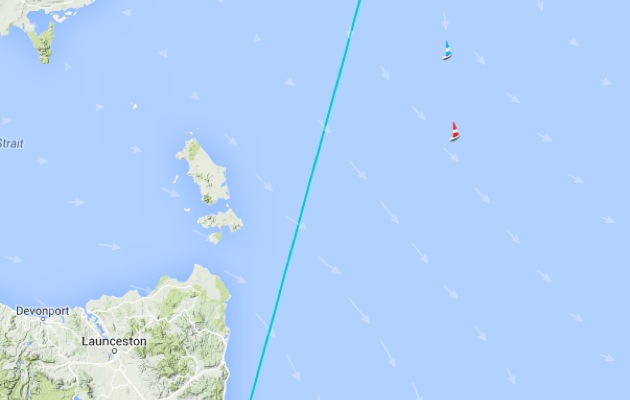Twenty four hours after the start of the Rolex Sydney Hobart, Wild Oats IX took the overall lead from Comanche.
Twenty four hours after the start of the Rolex Sydney Hobart, Wild Oats IX took the overall lead from Comanche. As the fleet ran into the forecasted lighter conditions on the approach to the Bass Strait, the task of keeping the speed on and pushing through to better breezes further south became critical. Every inch made in the tricky conditions were likely to be multiplied later. First to show the benefit of slipping through quickly was Wild Oats who has been gradually stretching her lead over Comanche.
Chasing a record eighth line honours win, Wild Oats XI overtook the early pacesetter, Jim Clark’s brand new supermaxi from the US, Comanche, as they passed Gabo Island at the eastern approach to Bass Strait at about 10 am.
The lighter conditions will have suited Wild Oats’ slender hull form better than the flat beamy sections of Comanche that was reported to be struggling in the light breeze. Could this transition prove to be the defining point of the 2014 Rolex Sydney Hobart Race?
Here’s an update on the official word from the race over the last 12 hours including more details following the delamination of Perpetual Loyal’s bow, forcing the team to retire.
Official race report excerpts:
Will the 70th edition of the Rolex Sydney Hobart Yacht Race have been decided between lunch and tea today?
That’s the conclusion that one might well draw from the huge difference in the performance of the Hamilton Island super maxi Wild Oats XI and her main challenger, the US boat Comanche
In the words of race photographer Daniel Forster, who flew over the fleet this afternoon, “Comanche looks like she’s stuck to the water”.
Having passed Comanche at about 10.00am as they entered Bass Strait in light airs, Wild Oats XI maintained a speed of 12-15 knots, twice that of Comanche, for most of the afternoon, until the lead had opened out to more than 20 nautical miles at 6 pm.
Meteorologists offered the view that Wild Oats XI had managed to sail through a ridge in Bass Strait, while Comanche had been stalled by it.
Asked why she was only doing 6.6 knots, Comanche tweeted, “No wind”.
With the wind expected to clock round from the west to the north-east during the night and strengthen, the leading boats may reach Tasman Island by early afternoon tomorrow, but they may also face light and variable winds in Storm Bay and the River Derwent. Those conditions may be Comanche’s only salvation.
Unfortunately for them, she appears to have found one of the few holes in the wind. Elsewhere, Forster reports, yachts were enjoying champagne sailing conditions.
The biggest casualty in the race so far is the third-placed super maxi Perpetual Loyal. She is making for Sydney having suffered hull damage during the night, caused either by slamming into the sea from the tops of waves or hitting something, according to afterguard crew Tom Slingsby.
“We’re not exactly sure what happened, we were coming off some big waves, but we also could have hit something during the night when we were falling off these waves,” he said.
Loyal is the eighth retirement.
Leading on corrected time is Sam Haynes’ Rogers 46, ADA Celestial. Sam is a Sydney veterinarian who is raising money for Assistance Dogs Australia, dogs for the disabled.
“We are going ok. All is well,” he said.
“Pretty nice, but the residual swell against the tide is making the kite trimmers and helm busy.”
Kevin Costin on Wedgetail nailed it at Green Cape this afternoon when he noted:
“It seems the navigators and tacticians have made some different calls here. It will be interesting to see who buys the beers!”
On board Wild Rose, navigator Jenifer Wells pondered the night that had been:
“The breeze wasn’t so bad; it was the strong current that made the seas rough.”
On Balance, skipper Paul Clitheroe reviewed the discomfort for all concerned:
“The old saying goes ‘shaken not stirred’ but last night we were both shaken and stirred; 25 to 28 knots from the south/south-east saw a very lumpy sea state.
“Balance, and I sure the rest of the fleet, spent the night either flying off the short but sharp seas or much to the dismay of the crew, charging straight through them.
“I’m not sure what is worse. The flying is OK, but landing a 52-foot carbon boat time and time again makes me very nervous. She crashes back into the water, the rig compresses and groans and off she goes again.
“Driving straight through a wave is much better for the boat, only we all get saturated.”




